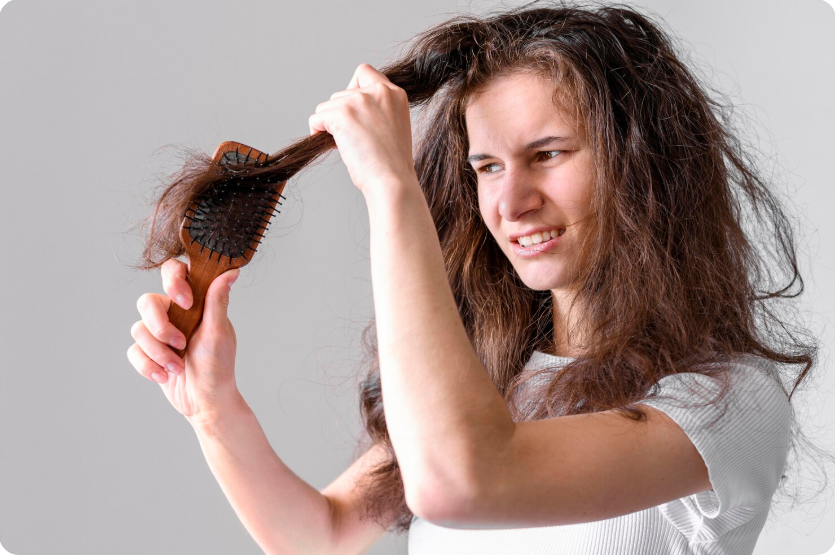Hair fall is one of the most common concerns today — affecting both men and women across all age groups. But before starting any treatment, it’s crucial to understand the root cause behind your hair loss. Hair fall can be triggered by several factors — stress, hormonal imbalance, nutritional deficiency, genetics, or medical conditions.
At Rakshaa Aesthetics, our dermatologists follow a detailed and scientific approach to diagnose hair fall accurately. This ensures that the treatment you receive is personalized, effective, and safe.
1) Recognizing the Kind of Hair Loss
Before starting with tests, your doctor first determines the type of hair loss you’re experiencing. Each type requires a different management plan.
a. Androgenetic Alopecia (Male/Female Pattern Baldness)
This is the most common type — caused by genetic and hormonal factors. In men, it usually appears as receding hairline or thinning at the crown. In women, it causes overall thinning, especially around the crown area.
b. Telogen Effluvium
If you notice sudden hair shedding a few months after illness, stress, or major surgery, it might be telogen effluvium. It happens when more hair enters the resting (telogen) phase and sheds all at once.
c. Alopecia Areata
This is an autoimmune condition where the immune system attacks hair follicles, leading to round bald patches on the scalp or body.
d. Scarring Alopecia
A rarer form of hair loss, where inflammation permanently damages hair follicles, leading to irreversible bald spots.
At Rakshaa Aesthetics, our dermatologists first assess these patterns through a visual and physical scalp examination before proceeding with detailed diagnostic tests.
2) Clinical Examination and Consultation
A comprehensive consultation is the first step in diagnosing hair fall. Your doctor will ask questions related to your medical history, lifestyle, diet, and family background.
What Your Doctor May Ask:
- When did you first notice hair fall?
- Is there a family history of baldness?
- Have you faced recent stress, illness, or hormonal changes?
- Are you taking any medications?
- What’s your diet like?
These questions help identify potential causes such as nutritional deficiencies, thyroid imbalance, or medication-induced hair loss.
At best dermatologist for hair loss in Delhi, this step ensures a customized treatment plan tailored to your specific condition — not just a generic remedy.
3) Diagnostic Tests for Hair Fall
Once the consultation is complete, specific tests help confirm the exact cause of hair loss.
a. Pull Test
A simple yet effective method where your dermatologist gently pulls a small section of hair (about 40–60 strands). If more than 6 hairs come out, it may indicate active shedding or telogen effluvium.
b. Hair Pluck Test (Trichogram)
In this test, a few hairs are plucked from the scalp and observed under a microscope. This helps assess the ratio of hair in different growth phases — anagen (growth), catagen (transition), and telogen (resting).
c. Scalp Examination (Trichoscopy)
Trichoscopy is a non-invasive dermatoscopic examination that magnifies the scalp and hair follicles. It helps identify:
- Miniaturized hair (seen in pattern baldness)
- Follicular density
- Signs of inflammation or scarring
- Scaling or infection
At Rakshaa Aesthetics, advanced digital trichoscopy devices are used to document scalp images and track progress over time.
d. Blood Tests
Blood investigations are often needed to detect underlying health issues contributing to hair loss:
- Thyroid function tests (T3, T4, TSH) – for thyroid-related hair loss
- Iron studies (Serum Ferritin, Hemoglobin) – for anemia or iron deficiency
- Vitamin D and B12 levels – for nutritional deficiencies
- Hormonal profile (Testosterone, DHEA, LH, FSH, Prolactin) – to check hormonal imbalance, especially in women
These tests reveal internal causes that can’t be detected through a visual exam alone.
e. Scalp Biopsy (in rare cases)
If scarring alopecia or autoimmune disorders are suspected, a small sample of scalp skin is taken and examined under a microscope. This helps in confirming conditions like lupus or lichen planopilaris.
4) Finding the Right Treatment Based on Diagnosis
Once the diagnosis is clear, your dermatologist will create a personalized treatment plan. Common treatment options include:
a. Medical Treatments
- Minoxidil: A topical solution that helps stimulate hair growth.
- Finasteride: An oral medication for men that reduces DHT hormone levels.
- Nutritional supplements: Iron, biotin, zinc, and vitamin D help support new growth.
b. Advanced Hair Regrowth Therapies
At Rakshaa Aesthetics, we offer the latest non-surgical treatments like:
- GFC (Growth Factor Concentrate) Therapy: Uses your own growth factors to naturally stimulate dormant follicles.
- PRP (Platelet-Rich Plasma): Involves injecting platelet-rich plasma from your blood into the scalp to improve hair density.
- Mesotherapy: Delivers vitamins and peptides directly to the hair roots.
c. Hair Transplant
If you have severe or permanent hair loss, a Hair Transplant may be the most effective long-term solution. At Rakshaa Aesthetics, experienced dermatologists like Dr. Rakesh Jangra ensure natural-looking results with advanced techniques like FUE (Follicular Unit Extraction).
Why Choose Rakshaa Aesthetics for Hair Fall Diagnosis?
At Rakshaa Aesthetics, Pitampura, we don’t just treat hair fall — we uncover why it’s happening.
Our diagnostic process is detailed, safe, and handled by expert dermatologists who specialize in both medical and aesthetic hair restoration.
With advanced tools like digital trichoscopy, safe procedures, and personalized care, we make sure you receive the right treatment at the right time.
FAQs on Hair Fall Diagnosis
Q1. How long does it take to diagnose hair fall?
Usually, a complete evaluation including consultation and trichoscopy can be done in one visit. Blood test results may take 1–2 days.
Q2. Is the diagnosis painful?
No. Most diagnostic procedures, like trichoscopy and pull tests, are completely painless.
Q3. Can stress alone cause hair fall?
Yes. High stress levels can trigger telogen effluvium — a condition where large numbers of hairs enter the shedding phase at once.
Q4. Should I start treatment before diagnosis?
No. Always get a proper diagnosis first. Using random oils or medications without knowing the cause may worsen your condition.
Q5. How soon can I see results after starting treatment?
It usually takes 3–6 months of consistent treatment to notice visible improvement, depending on the cause and treatment type.
Conclusion & Call to Action
Hair fall can be stressful, but the good news is — with the right diagnosis, it’s treatable.
At Rakshaa Aesthetics, our experts use advanced diagnostic techniques to find the real cause behind your hair loss and design a customized solution for you.
🌿 Take the first step toward stronger, healthier hair today.



